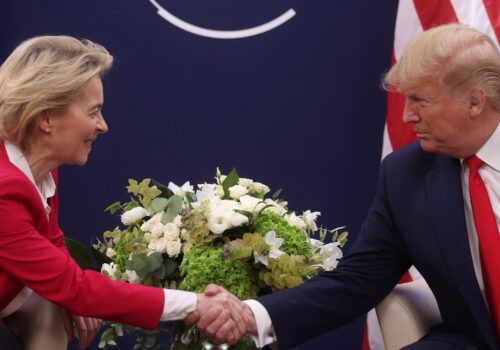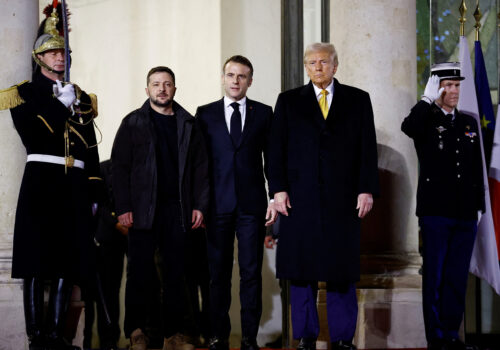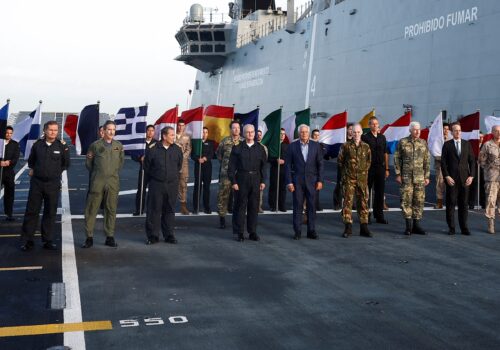The EU must become a strategic player in defense—alongside NATO
Facing a revanchist Russia and an increasingly transactional United States, European countries should finally start working on several parallel tracks to strengthen the continent’s deterrence and defense. As European members of NATO discuss additional military contingents to mobilize to defend themselves with minimal or—some fear—no support from the United States, it also is crucial for the European Union (EU) to step up to bolster Europe’s defense. The EU’s action is urgently needed on cross-border issues that have a direct impact on the continent’s deterrence and defense posture but remain largely uncovered by NATO.
European countries lack vital logistical interoperability with infrastructural bottlenecks and regulatory inconsistencies hindering military mobility across the continent. They duplicate many military platforms but, at the same time, fail to acquire critical capabilities such as air defense. A still highly fragmented European defense technological and industrial base is protected by narrow national interests and is thus unable to address capability gaps, replenish dwindling arms stocks, and compete on the global level on defense innovation.
In the current extremely demanding times, a refined NATO-EU alignment on defense would provide a critically needed burden sharing to eliminate these vulnerabilities and prepare Europe to withstand potential contingencies.
The NATO-EU nexus
The recent public remarks by representatives of the Trump administration, who repeatedly claimed that Europe must take ownership of conventional security on the continent, mean that an effective burden sharing must be established between European NATO members and the EU to meet the challenge. Both organizations have complementary roles in defense to play, and despite the recent shockwaves that the emerging new transactional American foreign policy has sent to its allies in Europe, the requirement for complementarity in the NATO-EU defense effort remains crucial.
NATO has highly integrated structures and procedures and has developed regional defense plans, predetermined capability targets, and military standards. These assets are the result of decades-long work and would not be easy to replace anytime soon. The United States remains a crucial member of the Alliance, especially in such areas as command and control (C2), intelligence, and long-range strike that would be difficult to replace in the short and medium term.
Strategically vital EU and NATO eastern flank member states—Estonia, Latvia, Lithuania, and Poland—insist on their reliance on NATO as the primary security guarantor. So do the Nordic countries including the newest NATO members, Finland and Sweden.
However, the ongoing dynamics of the past several weeks show clearly that the modus operandi of NATO is about to change with the shifting role of the United States in it. Working through flexible formations of “coalitions of the willing” will most likely replace the rather bureaucratic and, therefore, slow-working methods of past decades. This is not the first time that NATO has undergone a transformation, which is a natural process in a changing world. Working toward the same goal of keeping the Euro-Atlantic area safe is what counts. A repeated assurance will be needed from the United States on this.
The EU, for its part, still lacks both formal competencies and a unified political ambition to step deeper into the defense planning and execution field. At its core, the EU is susceptible to singular member states’ malfunction, as seen in Hungary under Viktor Orbán and Slovakia under Robert Fico, who constantly put brakes on such otherwise widely supported processes as tightening sanctions on Russia. Russia puts enormous effort into expanding the malfunction to other EU members as well: The latest example is the for-now-failed attempt to install a pro-Russian president in Romania. To become autonomous in defense, as repeatedly demanded by France, the EU must first reform internally.
Russia’s main objective is to divide and weaken its most significant strategic rival, NATO. Any attempts to offer alternatives to the Alliance’s primacy in European defense would eventually play into Putin’s hands, undermining deterrence and putting the frontline EU countries at immediate risk. Russia’s continuous rejection of Ukraine’s membership in NATO is—although void—an indication that NATO retains its deterrence power. Allies on both sides of the Atlantic should continue working on this credible deterrence to stay in place—with the EU being an important partner in this regard.
The answer to the current situation is a stronger European pillar in NATO, with the EU bearing a larger and better aligned burden with the Alliance by internalizing and fully embracing its distinct and unique role in security and defense as a defense enabler. Through its budgetary and regulatory authority, the EU can and must ensure that the necessary conditions for implementing NATO’s defense plans in Europe are completely satisfied. This particularly applies to critical areas such as military mobility and defense industrial readiness.
The EU’s role in military mobility
It is alarming that despite their commitment since 2017 to improve military mobility across the EU, European countries still have insufficient cross-border logistical interoperability and face immense bureaucratic obstacles when preparing military convoys for transportation across the EU. Germany and the Baltic states are the two most obvious cases in this regard, both because of the challenges they face and the strategic roles they play.
Due to its central location in Europe, Germany is considered Europe’s key hub in military logistics. Germany is home to major NATO bases including the Headquarters Allied Air Command in Ramstein, the Airborne Warning and Control System’s main base of operation in Geilenkirchen, and the Strategic Air Lift Interim Solution base in Leipzig, among others. Its territory stretches between Europe’s main seaports—Rotterdam, Antwerp, and Hamburg, which are crucial for incoming allied military supplies and reinforcements—and NATO’s and EU’s eastern flank countries Poland and the Baltic states. Germany’s inland waterways—the Rhine and Danube—provide the north-south transportation corridor toward Romania. What stretches in between is Europe’s longest railway network, which, as of 2022, had a total length of 38,836 kilometers of railway lines.
From a military logistics perspective, railways are considered crucial because they allow the transport of numerous pieces of heavy military equipment in one load. However, because of many years of underinvestment and neglect, Germany’s railways, roads, and bridges are in dire shape and often technically incapable of handling such heavy transport. Shortages in special railway wagons, which often have to be supplied by commercial providers, add to the existing problem. Finally, there are immense bureaucratic hurdles remaining within the EU (and even among Germany’s federal states) when it comes to documentation and permits to be acquired before military cargo can move from one state to another.
Thus, the EU should increase its efforts to speed up Europe-wide infrastructure upgrades, increase the state-owned fleets of railway wagons for military transport, and take decisive steps to implement a “Military Schengen” regime. Based on the experience of the free movement of passengers and goods within the EU, this regime is crucial to minimize the paperwork—and thus valuable time—involved in moving troops and military equipment across the EU.
The Baltic states’ logistical accessibility is another key issue in implementing NATO’s defense plans in this strategically vital gateway region. Their railways are primarily of a wide Russian gauge (1,520 millimeters), which is incompatible with the European standard gauge (1,435 mm) rail tracks. Thus, Lithuania, Latvia, and Estonia remain better connected to Russia and Belarus than to their NATO and EU allies.
The RailBaltica project, designed to connect the Baltic capitals with Warsaw via an 870 km long European standard-gauge rail track, is facing significant cost overruns and delays. Now scheduled for completion by 2030, RailBaltica is crucial for the deterrence and defense of the Baltic states—especially considering potential obstacles in sending allied reinforcements and military supplies by ship through the congested Baltic Sea, given the substantial Russian military presence in the Kaliningrad exclave. The EU has already provided financial support for this project, but more assistance—and institutional clarity—is needed, particularly in terms of an EU-level centralized management oversight of this and other military mobility projects. After more than fifteen years of planning, the RailBaltica project, just like other infrastructural upgrades in the EU, must finally be prioritized politically, providing a necessary push and support to the implementing member states.
Europe needs a defense industrial revamp
Russia’s war of aggression against Ukraine has exposed Europe’s dysfunctional defense industrial landscape. The issue involves three factors: the status quo situation (current capability gaps and insufficient ammunition stocks), demand-side shortcomings, and supply-side risks. Whereas NATO’s main—though not sole—instrument to address this issue is to increase the target for member states’ defense spending, the EU has signaled the ambition to employ a more comprehensive approach. What started with the European Defense Fund to finance joint research and development projects in defense is now to be expanded through the still-under-negotiation European Defence Industry Programme (EDIP) to the areas of defense production and joint procurement. Action is urgently needed, but there is a risk of overstretching and losing focus on what really matters now and in the future.
What matters now is closing capability gaps, particularly in air defense, and filling Europe’s depleting ammunition stocks. It has been estimated that at the current production levels, Europe would need ten years to replenish its ammunition stocks in order to be prepared to defend itself. This timeline is far too long, considering German intelligence warnings about a potential Russian attack on European NATO member states by the end of this decade. While NATO sets its stockpile targets, the EU must utilize its regulatory powers and funding initiatives to push its member states to reach them.
Some short-term measures, such as the Act in Support of Ammunition Production, have already been implemented and are set to be transformed into long-term financing instruments through the EDIP. The proposal from the EU’s commissioner for defense and space, Andrius Kubilius, to implement mandatory ammunition stockpiles for EU member states, requiring them to meet NATO’s targets by 2030, would mirror similar EU measures in other critical areas, such as energy.
The discussion surrounding the increase of defense industrial production and joint procurement is closely tied to questions about potential adjustments to the current defense industrial supply and demand dynamics.
In terms of supply, the EU seeks to promote the purchase of arms manufactured by the European defense industry to strengthen and consolidate it while also avoiding restrictions on the use of weapons produced by foreign companies. Financial considerations are directly linked to this matter. Currently, the EU is divided into two main factions: one advocating for this European solution, and the other arguing that non-EU NATO allies—primarily the United States, UK, and Norway—who are major players in the defense industry, along with other key partners such as South Korea, should not be excluded from the EU’s funding mechanisms. On the demand side, the EU seeks to incentivize joint procurement by its member states to allow for bigger, cheaper, and more predictable orders, which would also lead to better standardization and interoperability of military equipment in use by the Europeans.
Keeping the non-EU NATO allies in the loop when contemplating new funding options is crucial for sustaining their commitment to Europe’s defense and accessing currently available off-the-shelf purchases of ammunition and legacy military platforms urgently needed in Europe in the short term. European countries such as Poland and the Baltic states are increasing their defense spending faster than any other European NATO member and are willing to spend the money on military platforms that meet three basic criteria—made by an allied country, proven to be of good quality, and available in the near future—making them eager buyers of US and South Korean production. Given their proximity to a potential future front line and their commitment to securing it for the sake of a free Europe, these choices should not be neglected in future EU funding schemes.
In the short term, instead of supply-side isolationism, demand-side corrections should be prioritized in the EU’s effort to play a more active role in strengthening the European defense technological and industrial base. With the EU’s support, favorable arrangements can be negotiated with foreign arms manufacturers, including fulfilling some parts of their contractual obligations in the EU, for example, in the areas of production, assembly, or servicing, and thus contributing to local economies, skill development, and sustainment of purchased arms’ life cycles locally while also securing the delivery of best quality, battlefield-proven military platforms for the European armed forces.
Thoughts on harsher supply-side interventions should be directed toward fostering the consolidation of emerging defense technology hubs in Europe. The defense industry is experiencing major tectonic shifts, with AI, drones, and robots entering the battlefield more rapidly than ever imagined. This is the area where the EU still has a chance to enter the global innovation race in defense and thus should focus on funding local defense and dual-use start-ups. It is high time to shift attention to niche technologies being developed in smaller EU member states, such as laser technologies in Lithuania and cyber technologies in Estonia, not to speak of the vast defense tech laboratory emerging in Ukraine, an EU candidate country. If properly funded, these EU-made technologies could soon bolster Europe’s deterrence and defense as crucial force multipliers.
Aligning NATO’s targets with EU defense initiatives
For the EU to embrace the role of a defense enabler means working out common NATO-EU mechanisms for transforming NATO’s targets into complementary EU defense initiatives in areas requiring increased cross-border European cooperation. Better interorganizational communication is crucial in this respect to avoid any potential duplication. At the same time, paying attention to non-EU allies’ involvement in EU defense industrial efforts is vital. The allied defense technological and industrial base must be interoperable across the Euro-Atlantic security area and should even look more proactively outward to provide a response to the growing strategic competition with the Russia-China-Iran-North Korea axis that—through involvement in Russia’s war against Ukraine—are also consolidating their military technological base.
The goal for both priority areas—military mobility and defense industrial revamp—is to scale up European rearmament, speed up allied deployment and reinforcements, and send a clear message to our strategic competitors: NATO and the EU are mutually reinforcing entities that aim to expand, not retreat. While a more far-reaching burden sharing with the United States on European defense is surely a huge challenge, it also is an opportunity for Europe to finally become a strategic player in defense.
About the author
Related content
Explore the program

The Europe Center promotes leadership, strategies, and analysis to ensure a strong, ambitious, and forward-looking transatlantic relationship.
Image: NATO Secretary General Jens Stoltenberg and European Commission President Ursula von der Leyen give a statement before a meeting with EU Commissioners in Brussels, Belgium, January 11, 2023.REUTERS/Johanna Geron



